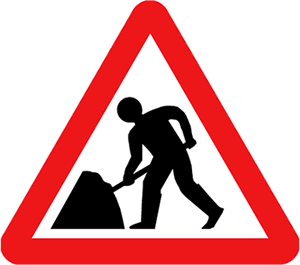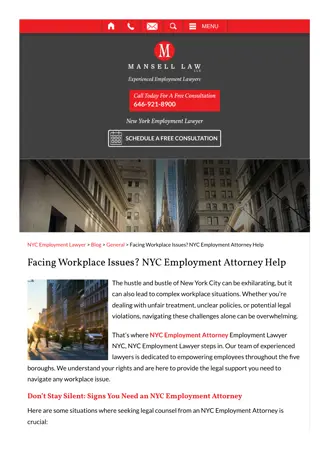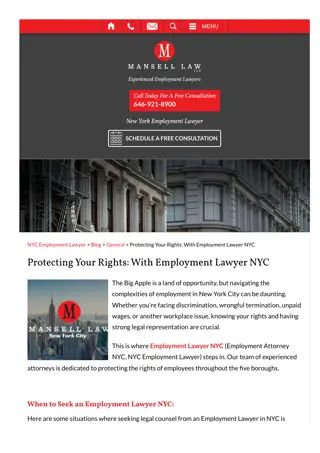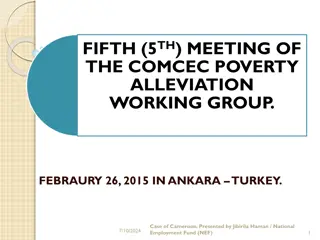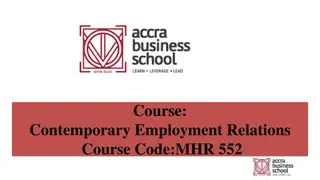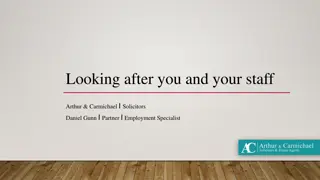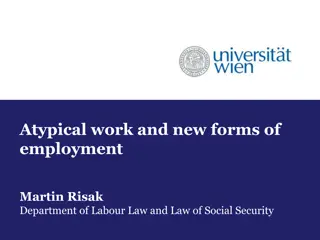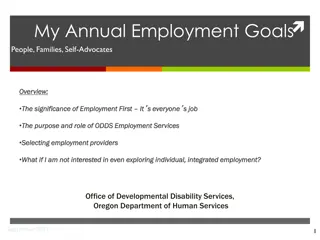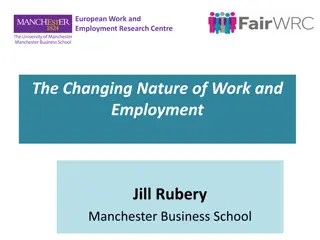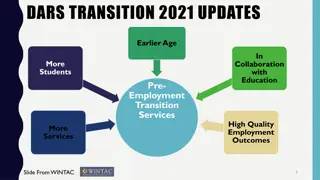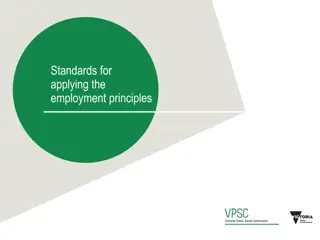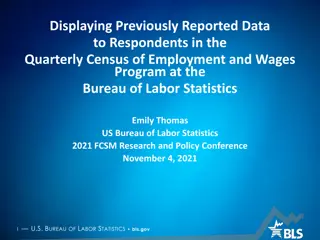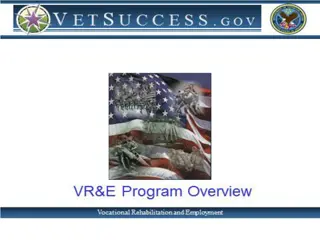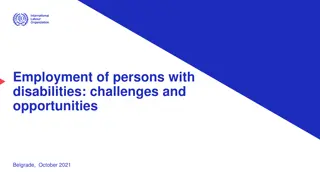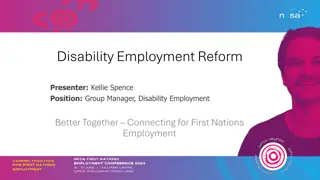Exploring Work and Employment Dynamics
Work involves activities that require effort, while employment entails receiving payment for work done. Employers hire workers who work for them, while self-employed individuals work for themselves. Leaving school for the working world presents challenges like time and money management, new relationships, rights and responsibilities, and freedom. Contrasting school with work, we see differences in hours, income, demands, and practicality. Various types of work include charity work, housework, homework, voluntary work, and self-employment, each with unique benefits both financial and non-financial, such as security, self-esteem, and acquiring new skills.
Uploaded on Sep 13, 2024 | 0 Views
Download Presentation

Please find below an Image/Link to download the presentation.
The content on the website is provided AS IS for your information and personal use only. It may not be sold, licensed, or shared on other websites without obtaining consent from the author.If you encounter any issues during the download, it is possible that the publisher has removed the file from their server.
You are allowed to download the files provided on this website for personal or commercial use, subject to the condition that they are used lawfully. All files are the property of their respective owners.
The content on the website is provided AS IS for your information and personal use only. It may not be sold, licensed, or shared on other websites without obtaining consent from the author.
E N D
Presentation Transcript
Work: Work can be defined as an activity which requires effort e.g. washing the dishes. Employment: Employment is when payment is received for working e.g. washing dishes in canteen and getting paid. debshoganteaching
Employers: People who hire workers in return for payment. Employees: People who work for employers. Self Employed: People who work for themselves. debshoganteaching
What challenges will you face when you leave school & start your working life?? Time Management Money Management New relationships & different roles Rights Responsibilities Freedom & Independence debshoganteaching
SCHOOL WORK Hours are longer you may have to work evenings, weekends, flexi time. Work is more practical than school Income - you get paid for work. More variety in day to day work. Different types of demands e.g. must be committed. Hours are shorter 9.00 to 4.00 Work theory sitting at a desk in school. Income don t get paid for school. Different classes each day. Different types of demands e.g. school has homework. debshoganteaching
Employment Charity Work Housework Homework Voluntary Work Self Employment debshoganteaching
Non-Financial Benefits: Security: able to plan for the future. Self-esteem: being useful, doing worthwhile things. Promotion: good morale & motivation. Possibility of travel. Acquire new skills/experiences. Acquire new friends: social aspect. Financial Benefits: Wages/salary Bonus Benefit-in-kind e.g. car Overtime debshoganteaching
Non-Financial Benefits: Being your own boss/make decisions. Self-esteem: doing something worthwhile Sense of achievement. Respect. Possibility of travel. Acquire new skills/experiences. Security: able to plan for the future. Financial Benefits: Wages/salary Benefit-in-kind e.g. car Share of profits/dividends debshoganteaching
Helping others. Acquiring new skills/experiences. Improve Curriculum Vitae. Enhanced reputation & respect. Sense of achievement. Achieving one s own goals. Possibility of employment, should a vacancy arise. debshoganteaching
1. Safety, Health & Welfare at Work Act 2. The Employment Equality Act 3. The Protection of Young Persons Act debshoganteaching
The Health & Safety Authority is responsible for enforcing the Safety, Health& Welfare at Work Act. The Health & Safety Authority - a state sponsored body - is responsible for developing and promoting new laws and standards. They promote good advice, research & information on H & S in the workplace. Inspects workplaces & investigates accidents. debshoganteaching
Employers must provide safe working conditions for all employees e.g. safety signs should be clearly visible Safety Statement this is a written document that identifies hazards, assesses risks and makes changes to ensure the workplace is safe. A safety statement is required by law. debshoganteaching
They should provide safety training, information & instructions where necessary Anti bullying policy Health & Safety Representative Provide safe & protective clothing, footwear & equipment. debshoganteaching
Employees should take responsibility for their own health, safety & welfare They should use Personal, Protective Equipment and protective clothing Follow training & instructions carefully Report any dangers / injuries to the Health & safety Representative Ensure there is no bullying in the workplace debshoganteaching
This act is designed to protect the health of young workers in Ireland and ensure that work carried out during school years does not put a young persons education at risk Young people have rights and should not be exploited Take Notes https://www.youtube.com/watch?v=3IqVY4U0Nmo debshoganteaching
The Act sets minimum age limits for employment, rest intervals and maximum working hours and prohibits the employment of anyone under 18 on late night work. The Act also requires employers to keep specified records for workers under 18. debshoganteaching
Employer must: 1. See a copy of birth cert Pair Work List Information an employer should keep 2. Keep a full register full name, D.O.B., time work begins / ends each day, rates of wages, total amount of wages. debshoganteaching
Employers cannot employ children aged under 16 in regular full-time jobs. Children aged 14 and 15 may be employed as follows: Doing light work during the school holidays they must have at least 21 days off work during this time As part of an approved work experience or educational programme where the work is not harmful to their health, safety or development debshoganteaching
Children aged 15 may do 8 hours a week light work in school term time. The maximum working week for children outside school term time is 35 hours or up to 40 hours if they are on approved work experience. debshoganteaching
The maximum working week for young people aged 16 and 17 is 40 hours with a maximum of 8 hours a day. Young persons are only permitted to work between 6am and 10pm. Any exceptions to this rule must be provided by regulation see Licensed premises' below. debshoganteaching
general duties in a licensed premises to be required to work up to 11pm on a day that does not immediately precede a school day debshoganteaching
Rest Breaks Age Age Under 16s 16 and 17s 30 minutes break after working 4 hours 4 hours Every 24 hours 14 hours off 12 hours off Every 7 days 2 days off 2 days off debshoganteaching
All employees are entitled by law to a payslip. The national minimum wage is 9.25 per hour. Recommended to increase to 9.55 this year. This does not mean that everyone is automatically entitled to receive this. Young people aged under 18 are only guaranteed up to 70% of the national minimum wage which is 6.48 per hour. Your employer is, of course, free to pay you more than the minimum wage if they wish debshoganteaching
Employers must give employees aged under 18 years a copy of the Act along with other details of their terms of employment within one month of taking up a job. Employers must also display the official summary of the Act at a place in their workplace Employers can get a fine of up to 1,904.61. Continuing breaches of the Act can attract a fine of up to 317.43 a day. Homework Summary report on Visit In debshoganteaching
Aims: Promote equality Prohibit discrimination discrimination is when one person is treated in a less favourable way than another person. Prohibit harassment harassment is any act or conduct which is unwelcome & offensive, humiliating or intimidating. All employees are entitled to equal work for equal pay. Pair Work list examples of discrimination in the workplace. Note 9 grounds https://www.youtube.com/watch?v=iZ6rKSo1tQs Note what discrimination is mentioned https://www.youtube.com/watch?v=8EryFfMsm58 https://www.youtube.com/watch?v=bkVXnlHFsdI debshoganteaching
This act outlines discrimination on nine grounds: 1. Gender 2. Marital Status 3. Family Status 4. Age 5. Disability 6. Religion 7. Sexual Orientation 8. Traveller community 9. Race debshoganteaching
It is against the law to discriminate in the following areas: 1. Recruitment 2. Training 3. Promotion 4. Dismissals 5. Conditions of Employment debshoganteaching
Employers must advertise Equal Opportunities Employer Diversity in the Workplace Benefits 1. Younger learns form older employee s experience and older can keep up to date. 2. Different backgrounds have different outlooks decision making easier. 3. Contacts in other countries. 4. Learn to be tolerant all the same regardless of gender, race etc. debshoganteaching
Promote good Industrial Relations Protect and represent workers to improve conditions. Better pay, & conditions (holidays, hours, facilities). Negotiate when disputes occur. Greater strength by working together. Shop Steward elected by workers, represents, recruits, informs. Examples SIPTU, Impact, TUI, ASTI Labour Relations Commission, Rights Commissioner, Equality Officer, Labour Court. debshoganteaching
Advantages regular income, dont worry about finding a job, pension, security. Disadvantages stay in job, work is the same, full time less family and leisure time, less motivation. Job-share, flexitime, time rate, piece rate, commission, profit-sharing. debshoganteaching
Employers name and address Employee s name and address Job Title & Description Start date Salary Holidays, pension Duration of contract Any other conditions location, hours signatures debshoganteaching
Training schemes solas (Fs), springboard, BTEA, VTOS, Youthreach. Pg 29 Options retrain courses Set up own business, volunteer, part-time work/courses, other countries. Changes in employment work form home, technology, part-time/flexi/ job share, services, self employed, changes from construction/factory to tech/ pharma industry. debshoganteaching
Employees Employer s - Book debshoganteaching
Sex Stereotyping: making assumptions that there is a distinction between men s work & women s work ! Do you agree?? Glass Ceiling There is a gender imbalance in the higher levels of management and women find it particularly difficult to rise above a certain level. Do you agree?? debshoganteaching




